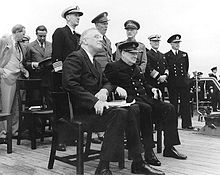Harold Raynsford Stark
He also orchestrated the navy's change to adopting unrestricted submarine warfare in case of war with Japan;[2] Stark expressly ordered it at 17:52 Washington time on 7 December 1941,[3] not quite four hours after the Japanese attack on Pearl Harbor.Forrestal concluded that both Kimmel and Stark had "failed to demonstrate the superior judgment necessary for exercising command commensurate with their rank and their assigned duties.[15] Stark's most controversial service involved the growing menace of Japanese forces in the period before America was bombed into the war by the attack on Pearl Harbor.In his book, And I Was There: Pearl Harbor and Midway – Breaking the Secrets (1985), Layton maintained that Stark offered meaningless advice throughout the period; withheld vital information at the insistence of his Director of War Plans, Admiral Turner; showed timidity in dealing with the Japanese; and utterly failed to provide anything of use to Kimmel.[16] John Costello (Layton's co-author), in Days of Infamy (Pocket, 1994), points out that Douglas MacArthur had complete access to both PURPLE and JN-25, with over eight hours warning, and was still caught by surprise.Moreover, as the Supreme Commander of the Allied Powers official historian Gordon Prange and his colleagues note in December 7, 1941 (McGraw-Hill, 1988), the defense of the fleet was General Walter C. Short's responsibility, not Kimmel's.[21] Stark maintained a family summer residence on Lake Carey in Tunkhannock, Pennsylvania, north of his native Wilkes-Barre, for many years and flew in by naval seaplane for weekends during his career.



Wilkes-Barre, PennsylvaniaWashington, D.C.Arlington National CemeteryVirginiaUnited States NavyAdmiralUnited States Twelfth FleetUnited States Naval Forces EuropeChief of Naval OperationsBattle FleetUSS West VirginiaUSS NitroWorld War IWorld War IINavy Distinguished Service MedalArmy Distinguished Service MedalUnited States Naval AcademybattleshipUSS MinnesotaUnited States Atlantic Fleetcruise around the worldtorpedo boatsdestroyersAsiatic FleetPhilippinesMediterraneanexecutive officerNorth DakotaWest VirginiaNaval War Collegeammunition shipcaptainSecretary of the NavyRear AdmiralBureau of OrdnanceHMS Prince of WalesAtlantic Charterexpansion of the navyNeutrality PatrolssubmarinesAtlanticPlan Dog memoEurope firstunrestricted submarine warfareattack on Pearl HarborLondon Naval TreatyEuropean Axis PowersErnest KingJames E. Wharton1st Engineer Special BrigadeLondonTwelfth Fleetlandings in NormandyAllied powersCharles de GaulleCourt of InquiryJames Forrestalaerial torpedoBjorn EgeliRichmond K. TurnerHusband E. KimmelEdwin T. LaytonChester W. NimitzDouglas MacArthurSupreme Commander of the Allied PowersGordon PrangeWalter C. ShortOffice of Naval IntelligenceNed BeachTunkhannock, PennsylvaniaWilkes-BarreGold StarsNavy Expeditionary MedalMexican Service MedalWorld War I Victory MedalAmerican Defense Service MedalAmerican Campaign MedalEuropean-African-Middle Eastern Campaign Medalbattle starWorld War II Victory MedalOrder of the British EmpireLegion of HonorCroix de Guerre 1939-1945USS Stark (FFG-31)Wilkes UniversityNaval Surface Warfare Center Dahlgren DivisionEdward AndrewsTora! Tora! Tora!public domainDictionary of American Naval Fighting ShipsB. Mitchell SimpsonInternet Archive20th Century Press ArchivesWilliam D. LeahyErnest J. King